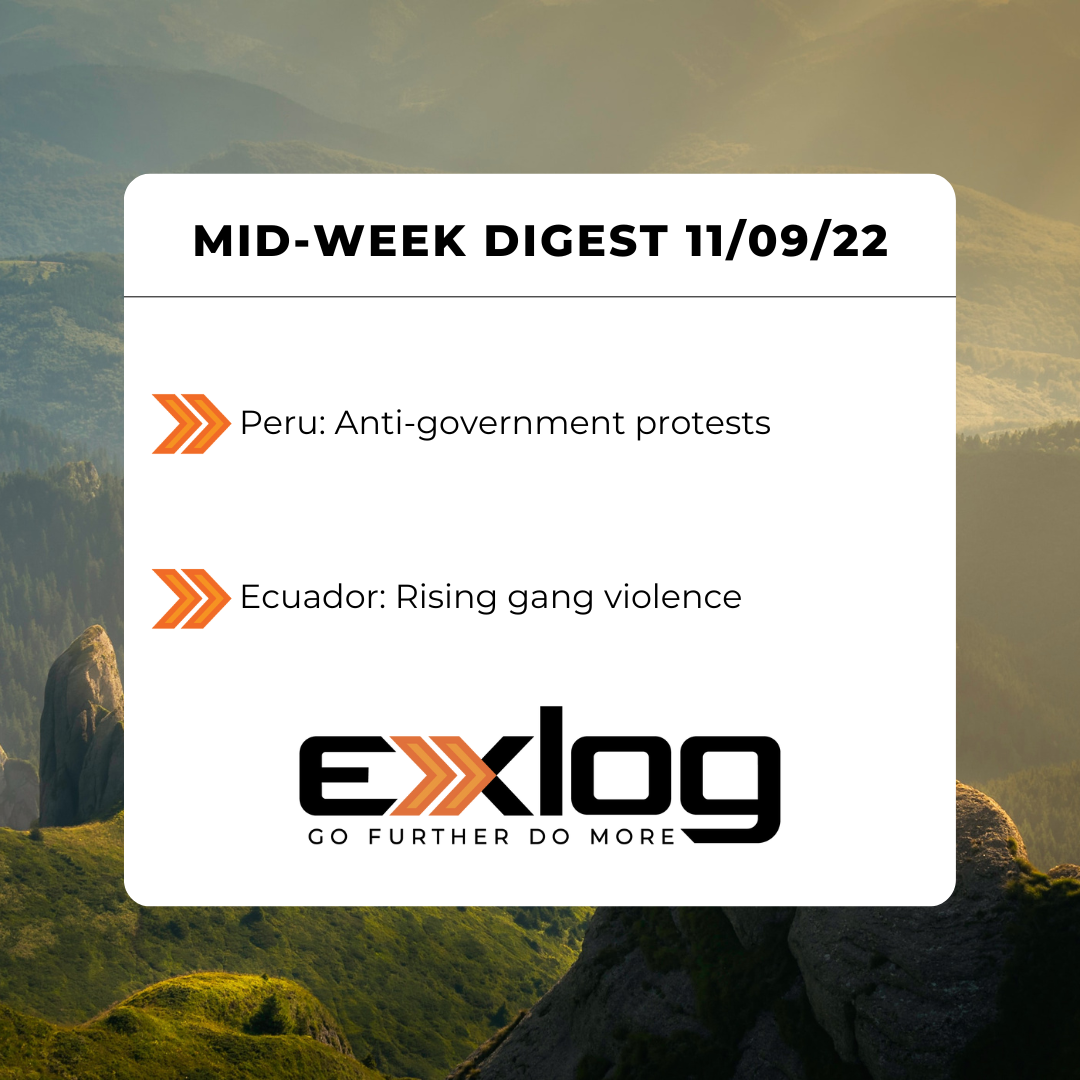Anti-government protests in Peru and rising gang violence in Ecuador
Peru: Recent Protests highlight deep dissatisfaction with government
Several anti-government protests swept Peru during the first week of November, resulting in travel disruptions in Lima and the detention of local and foreign tourists in the Loreto department, located in Peru’s Amazon rainforest. On Nov. 5, thousands of Peruvians held demonstrations in Lima, Piura, Trujillo, and other cities in northern, central, and southern Peru to demand the resignation of President Pedro Castillo, who is being investigated for corruption and has survived two impeachment attempts since taking office in July 2021. While most of the demonstrations proceeded peacefully, the protests in Lima escalated to violence when protesters clashed with riot police, prompting the security forces to deploy tear gas to disperse the crowd. The rallies prompted widespread travel disruptions in centrally located neighborhoods of the capital as authorities blocked several roads to prevent protesters from reaching the Government Palace. Simultaneously, anti-government sentiment has also grown in rural areas over environmental concerns. Two days before the anti-Castillo demonstrations, members of the Cuninico indigenous community detained 150 people – including local nationals and foreign tourists – traveling on boats on the Marañón River in the northern region of Loreto. The boat seizures were aimed at raising awareness about perceived government inaction to address an oil spill into the Cuninico River that occurred on Sept. 16. Locals freed the tourists on Nov. 4 but vowed to continue blocking traffic on a section of the Marañón River. Peru declared a state of emergency in the affected area – home to 2,500 indigenous people whose livelihoods depend on local rivers – on Sept. 24, although the government has done little to minimize environmental contamination. According to the state oil company Petroperú, an intentional cut in the Norperuano Pipeline – which transports crude oil from the Amazon region to the city of Piura – caused the spill. While the exact circumstances of the incident remain unclear, Petroperú reported 11 attacks on its pipeline in Loreto between January and September, indicating that acts of sabotage targeting oil pipelines are common in the area. Peru has witnessed various disruptive episodes of civil unrest against President Castillo in recent months, and the latest incidents further underscore the public’s dissatisfaction with the government. Additional protests – potentially impacting travel, the tourism industry, and other economic sectors – are likely in the medium term.
Ecuador: Lasso declares state of emergency over rising gang violence
Ecuadorian President Guillermo Lasso declared a state of emergency (SoE) in the provinces of Guayas, Esmeraldas, and Santo Domingo de los Tsáchilas during the first week of November due to escalating gang violence, implementing a 2100-0500 curfew through Dec. 15 and restring public assembly. The decision to introduce the SoE followed a wave of gang-related attacks targeting security forces in Guayas and Esmeraldas provinces in retaliation for prison transfers and other measures aimed at reducing gang presence inside local penitentiaries. The attacks led to at least five police casualties; six of the nine reported incidents involved explosives, while the remaining attacks were shootings targeting police officers on patrol. Ecuador’s penitentiary centers are notorious for elevated levels of violence due to inter-gang rivalries; at least 400 inmates have been killed in prison riots since February 2021, compared to 103 prisoners killed in 2020. Disputes among various gangs – affiliated with rival Mexican drug trafficking organizations – have spilled onto the streets, triggering an increase in homicides in the northern provinces of Ecuador. Since the beginning of the year, the government declared four states of emergency in the city of Guayaquil – the capital of Guayas Province – which recorded 1,200 homicides between January and October, marking a 60% increase compared to the same period in 2021. Similar to the previous States of Emergency, President Lasso deployed 1,400 armed forces to Guayaquil, and additional deployments of security personnel are likely in the coming weeks. However, such steps will likely be inadequate to reverse Ecuador’s evolution in recent years from a drug transit destination to a major distribution center. This indicates a likely continued deterioration in the overall security environment in the country in the medium-to-long term as rival criminal organizations continue to vie for lucrative smuggling routes along Ecuador’s Pacific coastline.


